News | Press
#A02 A question of synchronism
- Machine: B100;
- Published in: Strade e Autostrade n.41;
- Author: Martino Garulli;
- Date: 10/2003
The renovation program of Italian railway tunnels plans to provide them with safety cables : there is one difficulty : all works have to be done without interrupting totally the railway traffic. The Italian railway has been for a long time a very frequent topic in the media due to the interest (and also polemics) that building new High Capacity railways lines creates continuously among the people. Of course, the huge character of the project is an obvious reason for the attention media grant it. Yet, this interest tends to underestimate other projects that the Italian Railway is planning, e.g to secure and adapt the existing railways on which run a part of all Italian passengers and almost all Italian goods. An important part of the renovation work is to put in safe and to provide with safety cables every tunnel longer than 5 km. A recent law obliges to renew all platforms and cables of the entire gallery. Such works are very complex from a logistical and scheduling point of view given because they have to include a series of factors by which usual construction sites are not concerned. An example of this type of construction site is the one close to Vasto on the railway Ancona-Bari, opened from April, the 7th which started effectively at the end of May: the necessary time to prepare formworks and plan an accurate working process.
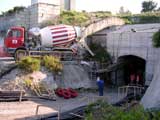 |
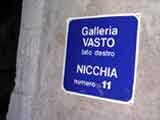 |
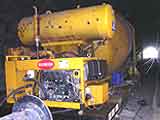 |
Cement and aggregates are delivered dry on the construction site with a truck-mixer |
Some information about the safety niche |
The mixer on wagon while pouring concrete |
The tunnel in question is part of a group including three tunnels and 60.000 meters platforms to be poured. One month after the construction site's opening (June 2003), some 8000 meters have been done with an average 200-250 meters a day. As the construction site's reponsible says, "our customer RFI (Rete Ferroviaria Italiana) asked us very high quality and safety standards that I, as a representative of Italfer who is in charge of the supervision of construction, must have them respected letter-perfect. Think that all works must be done in very short time (45 minutes in the morning, 3 hours and a half in the evening) to enable railway traffic to run the normal way. There were additional difficulties of materials supply and their transport on the site : you must know that it was a "mobile" construction site that moves along the railway, as the works went on. Therefore, we mounted a mixer on wagon made for this purpose, bringing the concrete to be poured as close as possible from the working site." Platforms have been raised in the whole tunnel on both sides through concrete being poured in steel formworks built on purpose for this kind of works. The formworks' shape has a lateral space to receive water supply hoses for fire protection systems. Besides, a series of hoses containing wires for the normal and emergency lighting and other safety cables will be added. Wires will be installed in order to enable mobile phones to work in the tunnel. Pouring phases preview a team of workers preparing steel formworks in which concrete is poured (low grain size RCK 25), especially mixed with water reducing admixtures through a B100 screw pump supplied by Bunker from Casandrino.
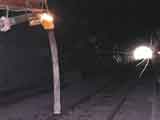 |
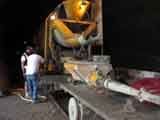 |
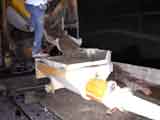 |
The mixer on wagon ready to start pouring |
The B100 mounted on wagon |
Feeding the B100 concrete pump |
"The screw pump used to convey concrete on the opposite side has been also mounted on wagon" says surveyor Sabuci (responsible of works). "This way, we managed to speed up filling operations : concrete was mixed in the truck-mixer (cement and aggregates are delivered dry on the site) and unloaded in the hopper which conveys it in a rubber hose. Concrete must be fluid given the complex formworks' shape and its dense reinforcements : using a too viscous material would mean to diminish the platform's quality and cause it to be damaged very soon. You could risk to have unadapted reinforcement concrete cover thickness which could be the start of an accelerated damaging process. It's extremely important to respect the synchronism of the working team generally made of 3-4 operators working quickly and precisely to guarantee a good quality concrete pouring (right tamping and homogeneity of the platform's surface) but also to maximize the truck-mixer's unloading phases. I repeat that working hours are very few and permit us, if everything happens the way it should, to have maximum two working cycles (assembling formworks - truck-mixer filling - concrete conveying and so on)." The working team is coordinated by a supervisor whose job is optimize the concrete's fluidity according to the operators' demands : a worker is in charge of unloading concrete, two of them distribute the material (very fluid for a right tampering) and the fourth levels the surface and eliminates excess concrete. We stop pouring concrete at the level of maintenance and safety niches where electricity main control wells and control electric boxes are built. "The concrete pump we used (the B100 model of Bunker) is the only easy solution to pump concrete in platforms on the opposite side of the truck-mixer on wagon. We filled about 4000 meters platforms with this system. Using the B100 reduced drastically concrete wastes along the tunnel and improved concrete's homogeneity.
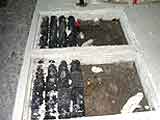 |
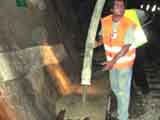 |
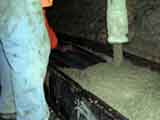 |
A detail of protection gaiters for the electricity network |
Pouring concrete in the gaiters |
A close-up picture of gaiters |
Powerful, reliable and safe
The B100, manufactured by BUNKER from Casandrino (Naples) is a polyvalent screw pump used for concrete with grain size up to 25 mm, traditional and special mortars, fibre-reinforced mortars, self-levelling floor screeds, light concrete. It's ideal to spray plasters and concrete up to 8 mm (spritz-beton), inject cement or special mixes in walls, micropiles and anchoring ties.
The B100 pumps materials until 45 meters horizontally and can reach 15 meters of pumping height.
The machine is controlled by an hydraulic power-pack with silenced 18,5 kW Diesel engine (also available in electric version) with an hydraulic output of 60 l/min.
Such features make possible reaching a regulable theoretical output of 250 l/min and a theoretical working pressure of 12 bars. All versions are equipped with hopper and feeding screw. The pump can be powered by its power-pack or whatever building machine with appropriate P.T.O : excavators, loaders, drilling rigs.
The B100's tools offer a large variety of uses : you can use a spray gun for plasters, one for joint filling, one for cement injections, one for sprayed concrete (steel and polyurethane).